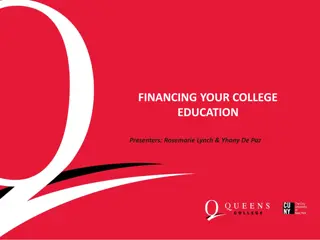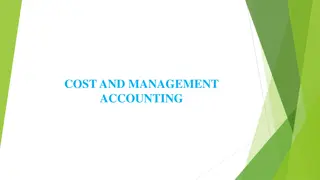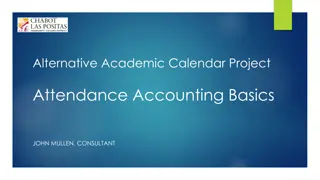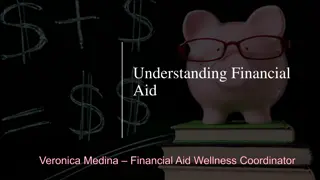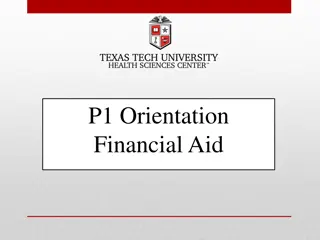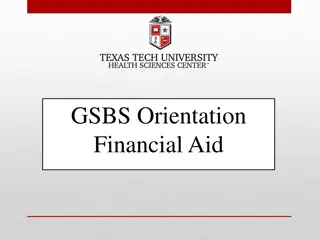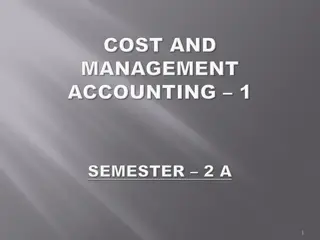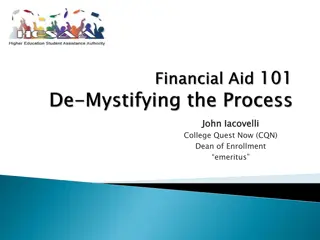Personal Accounting and Financial Aid for Education
In this module, you will explore the significance of accounting principles in personal finance, including funding education, creating a stable financial situation for your family, and planning for retirement. Learn how accounting can help you secure resources for education, understand financial aid options, work while studying, and identify additional sources of income. Discover common federal financial aid categories, such as grants, scholarships, work-study, and student loans. Find out key dates for filing the FAFSA and benefits of working during college. Uncover various sources of income beyond traditional aid programs.
Download Presentation

Please find below an Image/Link to download the presentation.
The content on the website is provided AS IS for your information and personal use only. It may not be sold, licensed, or shared on other websites without obtaining consent from the author.If you encounter any issues during the download, it is possible that the publisher has removed the file from their server.
You are allowed to download the files provided on this website for personal or commercial use, subject to the condition that they are used lawfully. All files are the property of their respective owners.
The content on the website is provided AS IS for your information and personal use only. It may not be sold, licensed, or shared on other websites without obtaining consent from the author.
E N D
Presentation Transcript
Financial Accounting Module 0: Personal Accounting
Module Learning Outcomes Discuss the importance of accounting principles in your personal life 0.1: Use your knowledge of accounting to garner resources to fund your education 0.2: Use your knowledge of accounting to create a healthy financial picture for you and your family 0.3: Use your knowledge of accounting to finance your retirement and leave a legacy for your loved ones
Learning Outcomes: Financing Your Education 0.1: Use your knowledge of accounting to garner resources to fund your education 0.1.1: Demonstrate an understanding of financial aid options 0.1.2: Recognize the pros and cons of working while studying 0.1.3: Identify other potential sources of income available while attending school full or part time
Financial Aid Common federal financial aid can be broken into four categories: Grants Scholarships Work-Study Jobs Student Loans To access Federal financial aid, you must first fill out a Free Application for Federal Student Aid, or FAFSA.
Filing for Financial Aid October 1, 2021: First date you can file your FAFSA for the 2022 2023 school year Late spring, 2021: The 2020 2021 school year ends, but the 2020 2021 FAFSA is still available until June 30 Fall 2021: School year begins; financial aid awarded based on your 2021 2022 FAFSA, but it s also time to file your 2022 2023 FAFSA Late spring 2022: School year ends the last possible chance to access FAFSA is June 30, 2022
Working While Studying Benefits of Working in College Reducing Debt Employer Benefits Time Management Financial Management Work Experience Networking
Other Sources of Income Government Listings special aid programs or additional aid eligibility for serving in the military or for being the spouse or child of a veteran education awards for community service with AmeriCorps educational and training vouchers for current and former foster care youth scholarships and loan repayment programs through various institutions Scholarship Opportunities Your College's Financial Aid Office Savings Account Tax Benefits
Learning Outcomes: Financing the Present 0.2: Use your knowledge of accounting to create a healthy financial picture for you and your family 0.2.1: Create and follow a family budget 0.2.2: Identify proper ways to use and manage credit 0.2.3: Articulate how to buy a home and other major purchases 0.2.4: Apply accounting principles to properly minimize and file taxes
Budgeting Personal Finances When budgeting, remember that saving money (or paying off debt) is just as important as not running out of money. Budgeting can be tricky, as you have to pay attention to your money which isn t the most enjoyable task. However, if you don t look at your actual spend, you can t know where your money is going.
Budgeting Strategies Allocate funds to separate accounts First account for fixed expenses, like rent and car payment. Then have another section for discretionary spending, like eating out and entertainment. Follow the 50/30/20 rule: 50% (or less) goes to necessities such as housing, student loans, and utilities. These are expenses you have to pay every month. 30% (or less) goes to nice-to-haves, such as entertainment, hobbies, and travel. 20% (or more, if possible) goes toward savings and paying down debt.
Credit Establishing and building up good credit over time is an important element of sound financial health. Common ways to establish credit: Apply for a credit card Apply for a car loan Establish renting history Be wary of credit card usage credit card debt can negatively affect your credit score. Credit scores are generally classified as: Very poor: 300 579 Fair: 580 669 Good: 670 739 Very good: 740 799 Exceptional: 800 850
Buying a Car Benefits of Buying New better interest rates dealer incentives latest innovations Benefits of Buying Used avoiding depreciation: a new car loses ~30% of its value as soon as it s purchased typically less expensive than new car
Buying a House A traditional home mortgage is usually 80% of the value of the home, with a 20% down payment, although there are some assistance programs A House as a Liability insurance repairs and maintenance monthly payment A House as an Asset equity renting out for passive income
Taxes Taxes are what we pay for civilized society. Oliver Wendell Holmes, Jr. Anyone who makes more than the standard deduction ($12,400 in 2020) must pay income tax Student-Specific Tax Rules Scholarships are tax-exempt, unless the scholarship exceeds school costs (which include room and board, books, etc.) Student-Specific Tax Credits The American opportunity tax credit: for their first four years of undergraduate school, students are qualified to receive up to $2,500 in returns The lifetime learning tax credit: after their first four years, students can claim 20 percent of $10,000 of qualifying educational expenses
Practice Question 1 Charity planned a trip and decided to sign up for her first credit card. After she received it in the mail, she started to use it. She purchased an airplane ticket to New Orleans, booked a hotel and rental car. While on the trip she used the credit card to purchase meals, souvenirs and local music. When she returned she paid her credit card down to zero before the due date. If Charity continues to operate this way with her credit card, what future financial status will she be establishing? A. Use her credit card to pay for unnecessary things. B. Build a positive credit history and raise her credit score. C. Overstretch her budget and get in debt. D. Her present actions will not affect her financial future.
Learning Outcomes: Financing the Future 0.3: Use your knowledge of accounting to finance your retirement and leave a legacy for your loved ones 0.3.1: Describe common types of investments 0.3.2: Demonstrate an understanding of the time value of money 0.3.3: Identify various strategies to fund retirement
Investing Most commonly used types of investments: Stocks: a share of ownership in a single company Bonds: a loan to a company or government entity Mutual Funds: a mix of investments packaged together Rental Real Estate: you must purchase and manage (or pay someone to manage) property to then rent out
Present Value vs. Future Value The present value of an amount of money is essentially what a future amount of money is worth today. For example, you promise to give your daughter $10,000 for college once she enrolls five years from now. If your investment account grows at about 8% every year, you would need to put $6,806 in your account today. The present value of $10,000 five years from now, discounted at 8%, with interest compounded annually, is $6,806. The future value of $6,806 at 8% compounded annually is $10,000.
Retirement Accounts Company-Sponsored Retirement Plans Defined Contribution Plans: You contribute a percentage of your wages (typically 3 10%) into an investment account you can t access until you retire. Often, your employer will match all or a part of your contribution. Defined Benefit Plans: These plans provide a certain benefit according to a formula. For instance, the defined benefit (often called a pension) may be 60% of the employee s highest salary paid out for life after retirement, but only it the employee works for the company for 20 years. Individual Retirement Accounts IRAs are excluded from your taxable income for the year you make them, and the investments grow without being subject to tax until you withdraw the funds. ROTH IRAs come out of taxed income, but grow tax-free and no tax is due when the funds are withdrawn.
Life Insurance There are two basic types of life insurance term and whole life. Term Insurance is the simplest form of life insurance. It pays only if death occurs during the term of the policy, which is usually from one to 30 years. If you stop making the monthly payments, the policy expires. Whole life pays a death benefit whenever you die even if you live to 100. In these policies, both the death benefit and the premium are level throughout the life of the policy.
Practice Question 2 The XYZ Company now has enough employees to establish an investment account with a mutual fund company where employees can contribute toward their retirement and the company will kick in an additional 5% on top of employee contributions. What is this type of company sponsored retirement called? A. Roth IRA B. Defined Benefit Plan C. IRA D. Defined Contribution Plan
Quick Review How can you use accounting knowledge to garner resources to fund your education? What is your understanding of financial aid options? What are the pros and cons of working while studying? What other income sources are available while attending school full or part time? How do you create and follow a family budget? How do you use and manage credit properly? What are ways to buy a home and other major purchases? What accounting principles help you properly minimize and file taxes? What are common types of investments? What is time value of money? What are some of the various strategies to fund your retirement?





